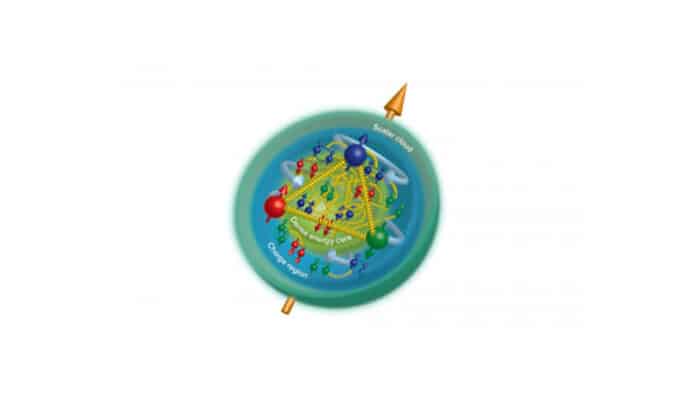The proton is one of the main building blocks of all visible matter in the Universe. Among its intrinsic properties are its electric charge, mass, and spin. These properties emerge from the complex dynamics of its fundamental constituents—quarks and gluons—described by the theory of quantum chromodynamics.
Little is known about the inner mass density of the proton, which is dominated by the energy carried by gluons. Gluons are hard to access using electron scattering because they do not carry an electromagnetic charge.
Now, Nuclear physicists may have finally pinpointed where in the proton a large fraction of its mass resides. A recent experiment carried out at the U.S. Department of Energy’s Thomas Jefferson National Accelerator Facility has revealed the radius of the proton’s mass that is generated by the strong force as it glues together the proton’s building block quarks.
By identifying the position of the matter produced by these gluons, this new measurement may have finally cast some light on the mass that is formed by the proton’s gluons. It was discovered that the proton’s nucleus is where this core of matter’s radius is located. The outcome also seems to suggest that the proton’s well-measured charge radius, which is frequently used as a proxy for the proton’s size, is not a good indicator of the size of this core.
Experiment co-spokesperson Mark Jones, Jefferson Lab’s Halls A&C leader, said, “The radius of this mass structure is smaller than the charge radius, and so it kind of gives us a sense of the hierarchy of the mass versus the charge structure of the nucleon.”
Zein-Eddine Meziani, a staff scientist at DOE’s Argonne National Laboratory, said, “This result came as somewhat of a surprise.”
“What we have found is something that we weren’t expecting to come out this way. The original goal of this experiment was a search for a pentaquark that has been reported by researchers at CERN.”
The experiment was carried out in Experimental Hall C of the DOE Office of Science user facility Continuous Electron Beam Accelerator Facility at Jefferson Lab. In the investigation, powerful 10.6 GeV electrons from the CEBAF accelerator were directed into a tiny copper block. By slowing down or deflecting the electrons, the block produced bremsstrahlung radiation in the form of photons. The protons inside a target made of liquid hydrogen were then hit by this photon stream. The electrons and positrons that were left over from these encounters were detected by detectors.
The experimenters were interested in those interactions that produced J/ Ψ particles amongst the hydrogen’s proton nuclei. The J/ Ψ is a short-lived meson made of charm/anti-charm quarks. Once formed, it quickly decays into an electron/positron pair.
Of the billions of interactions, the experimenters found about 2,000 J/ Ψ particles in their cross-section measurements of these interactions by confirming the coincident electron/positron pairs.
Jones said, “It’s similar to what we’ve been doing all along. By doing elastic scattering of the electron on the proton, we’ve been getting the proton’s charge distribution. In this case, we did exclusive photo-production of the J/ Ψ from the proton, and we’re getting the gluon distribution. In this case, we did exclusive photo-production of the J/ Ψ from the proton, and we’re getting the gluon distribution instead of the charge distribution.”
These cross-section observations could subsequently be incorporated by the collaborators into theoretical models that outline the proton’s gluonic gravitational form factors. The mechanical properties of the proton, such as its mass and pressure, are described in the gluonic form factors.
Meziani said, “There were two quantities, known as gravitational form factors, that we could pull out because we had access to these two models: the generalized parton distributions model and the holographic quantum chromodynamics (QCD) model. And we compared the results from each model with lattice QCD calculations.”
The experimenters established the aforementioned gluonic mass radius dominated by graviton-like gluons as well as a greater radius of attracting scalar gluons that extend beyond the moving quarks and restrict them from two possible combinations of these quantities.
The data hint at a scalar gluon distribution that extends considerably beyond the electromagnetic proton radius, which is one of the more intriguing results from our experiment.
Joosten said, “To fully understand these new observations and their implications on our understanding of confinement, we will need a new generation of high-precision J/ Ψ experiments.”
Jones said, “One possibility for further exploration of this tantalizing new result is the Solenoidal Large Intensity Device experiment program, called SoLID. The SoLID program is still in the proposal stage. If approved to move forward, experiments conducted with the SoLID apparatus would provide new insight into J/ Ψ production with the SoLID detector. It will be able to make high-precision measurements in this region. One of the major pillars of that program is J/ Ψ production, along with transverse momentum distribution measurements and parity-violating deep inelastic scattering measurement.”
The experiment was conducted for about 30 days in February-March 2019.
Journal Reference:
- Duran, B., Meziani, ZE., Joosten, S. et al. Determining the gluonic gravitational form factors of the proton. Nature 615, 813–816 (2023). DOI: 10.1038/s41586-023-05730-4
